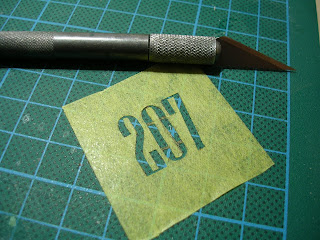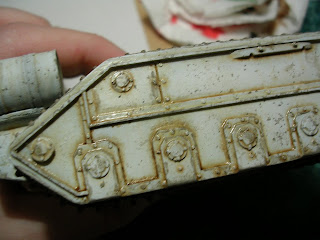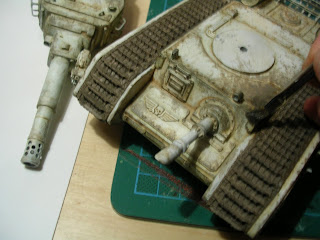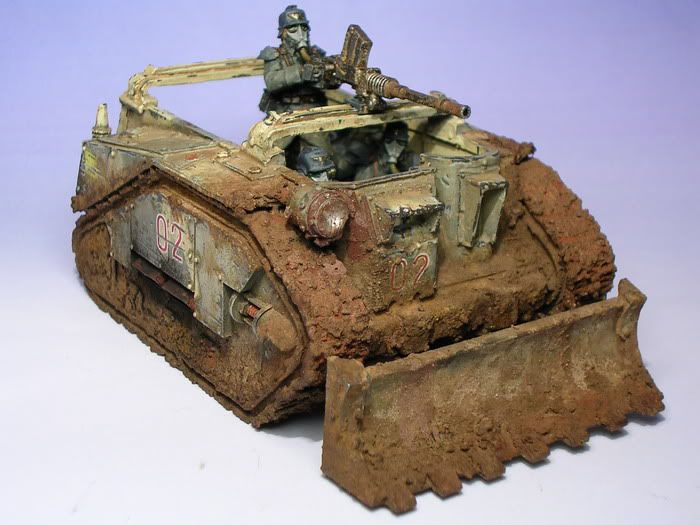(versión en Español)
PART I
PART II
PART III
PART IV
Well, time to start working again on the rusty Vanquisher!
I was looking for very big numbers on the turret, but as I did not have any suitable decals in my spare box, I decided to use a mask to paint them on.
After choosing the font I liked (Niagara), I printed it backwards using Corel Draw and a laser printer. If you don't have access to a laser printer, just use an inkjet and then do a photocopy. The trick here is using toner, ink will not work for our purposes.
PART I
PART II
PART III
PART IV
Well, time to start working again on the rusty Vanquisher!
I was looking for very big numbers on the turret, but as I did not have any suitable decals in my spare box, I decided to use a mask to paint them on.
After choosing the font I liked (Niagara), I printed it backwards using Corel Draw and a laser printer. If you don't have access to a laser printer, just use an inkjet and then do a photocopy. The trick here is using toner, ink will not work for our purposes.
 I then put some Tamiya Masking Tape on the table and using more masking tape, fixed the number "207" over it.
I then put some Tamiya Masking Tape on the table and using more masking tape, fixed the number "207" over it. I press the number now with a bit of paper soaked in a little acetone.
I press the number now with a bit of paper soaked in a little acetone. The toner is inmediately transferred to the masking tape.
The toner is inmediately transferred to the masking tape. I put a new blade in my cutter and carefully cut away the numbers. I do this twice.
I put a new blade in my cutter and carefully cut away the numbers. I do this twice. Note that I leaved some bits to hold the inside of the "0".
Note that I leaved some bits to hold the inside of the "0". I fix the mask to the turret, pressing with a blunt tool.
I fix the mask to the turret, pressing with a blunt tool. And prepare a mix of Tamiya XF7 Flat Red paint for my airbrush.
And prepare a mix of Tamiya XF7 Flat Red paint for my airbrush. I airbrush red paint at low pressure, allowing it to dry between layers.
I airbrush red paint at low pressure, allowing it to dry between layers. Finished.
Finished. Now I'll retouch the numbers with a brush and red and white paint.
Now I'll retouch the numbers with a brush and red and white paint. The model has a lot more of character now.
The model has a lot more of character now. You'll notice that it is enough to apply the point of the brush on a crack for the mix to freely flow by capillary action. Washes based on mineral spirits (both oils and enamels) are way better than their acrylic counterpart. Just remember that the wash must be controlled, overflowing the entire model with the tinted thinner will not give you a good result.
You'll notice that it is enough to apply the point of the brush on a crack for the mix to freely flow by capillary action. Washes based on mineral spirits (both oils and enamels) are way better than their acrylic counterpart. Just remember that the wash must be controlled, overflowing the entire model with the tinted thinner will not give you a good result. We let the oil dry for some minutes.
We let the oil dry for some minutes. And then we'll remove the excess with a soft brush and a little clean thinner..
And then we'll remove the excess with a soft brush and a little clean thinner.. We are going to give another weathering touch to the model drybrushing it. However, the drybrushing here is not used to make lighter areas, it's just to show more tear and wear.
We are going to give another weathering touch to the model drybrushing it. However, the drybrushing here is not used to make lighter areas, it's just to show more tear and wear.Enamels are great for drybrushing, they give you a lot of working time before drying. I prepare a dark gray-green mix for this part. I use here Revell #66 and a little of Humbrol #33.
 Dry the brush a little with some tissue.
Dry the brush a little with some tissue. And start softly drybrushing the model.
And start softly drybrushing the model. I look for the effect of older paint showing on worn areas.
I look for the effect of older paint showing on worn areas. I concentrate on rivets, corners and places where the crew would stand when accessing the vehicle.
I concentrate on rivets, corners and places where the crew would stand when accessing the vehicle. I am now going to add some depth to the model. I'll use Vallejo Model Color White paint for this.
I am now going to add some depth to the model. I'll use Vallejo Model Color White paint for this. I am going to paint a fine white line below any chipped paint areas to give them more volume. I also make some mapping* areas on places that I find they are too dark. I just put some paint in a random way, showing the colour below. The effect is very exaggerated, but I'll disguise it later on.
I am going to paint a fine white line below any chipped paint areas to give them more volume. I also make some mapping* areas on places that I find they are too dark. I just put some paint in a random way, showing the colour below. The effect is very exaggerated, but I'll disguise it later on.*Mapping is a technique I'll show you in other tutorial.
 This is the area before the white lining.
This is the area before the white lining. And after. At this distance the effect is too evident, but we'll soft it a little later on the final stages.
And after. At this distance the effect is too evident, but we'll soft it a little later on the final stages. I did use here some mapping and some lining.
I did use here some mapping and some lining. The idea is to make the area visually interesting.
The idea is to make the area visually interesting. Another view...
Another view... I am now going to do some rust in the sides. As this Ragnarok-Vanquisher had lost its track covers, those two areas should be rusted as it happens in real life after some time.
I am now going to do some rust in the sides. As this Ragnarok-Vanquisher had lost its track covers, those two areas should be rusted as it happens in real life after some time.I mask the area...
 ...And do a rust coloured mix done vith Vallejo Panzer Aces 301 Light Rust and 302 Dark Rust.
...And do a rust coloured mix done vith Vallejo Panzer Aces 301 Light Rust and 302 Dark Rust. I also do a crude mask ripping a piece of cardboard (Notice the mapped surface showing)
I also do a crude mask ripping a piece of cardboard (Notice the mapped surface showing) I airbrush the rust base, moving a little the cardboard mask during the process.
I airbrush the rust base, moving a little the cardboard mask during the process. This is a pure graphite stick.
This is a pure graphite stick. I use it to paint over those surfaces that are so worn out that the bare metal is showing. I use also my finger to blend it a little. I find that graphite gives a very subtle metal finish.
I use it to paint over those surfaces that are so worn out that the bare metal is showing. I use also my finger to blend it a little. I find that graphite gives a very subtle metal finish. Now I am going to add more rust with Humbrol #62.
Now I am going to add more rust with Humbrol #62. I paint the enamel on some recesses (it it's important not to overdo it).
I paint the enamel on some recesses (it it's important not to overdo it). You could also make some rust marks.
You could also make some rust marks. Once you are done, you let the enamel paint dry for a few minutes.
Once you are done, you let the enamel paint dry for a few minutes. Now the tank has more chromatic depth.
Now the tank has more chromatic depth.
Next time we'll finish the rusted areas and start working on the threads.
NEXT





9 comments:
Thanks for the tips and advice Still Learning. I am definitely going to try out the scouring pad technique, for creating mud on my Landraider.
Thanks a lot for sharing. You have done a brilliant job. Your article is truly relevant to my study at this moment, and I am really happy I discovered your website. However, I would like to see more details about this topic. I'm going to keep coming back here.
Thanks a lot for sharing. You have done a brilliant job. Your article is truly relevant to my study at this moment, and I am really happy I discovered your website. However, I would like to see more details about this topic. I'm going to keep coming back here.
Thanks for sharing Important tips..........
Keep posting.
It's a very good idea, thank nyou for thew inspiration, I will do it and use it as a mold for graffiti! Pretty nice job you did on that miniature tank.
Hello, i would like to read more about this interesting topic.
Doing such tutorials helps anyone to do things faster,
AMAZING DESIGN AND GORGEOUS!REALLY LOVE IT!!
AMAZING DESIGN AND GORGEOUS!REALLY LOVE IT!!
Post a Comment